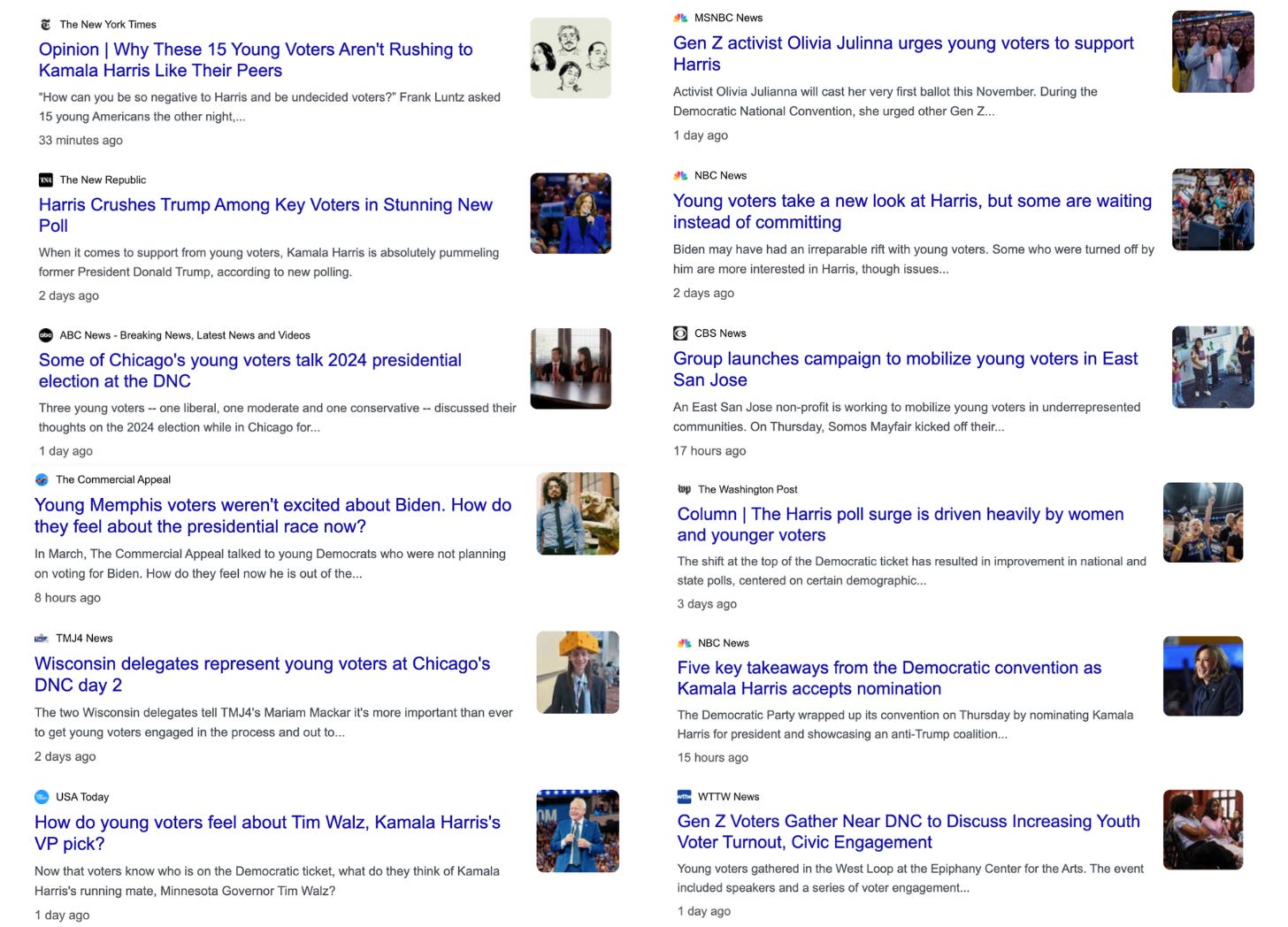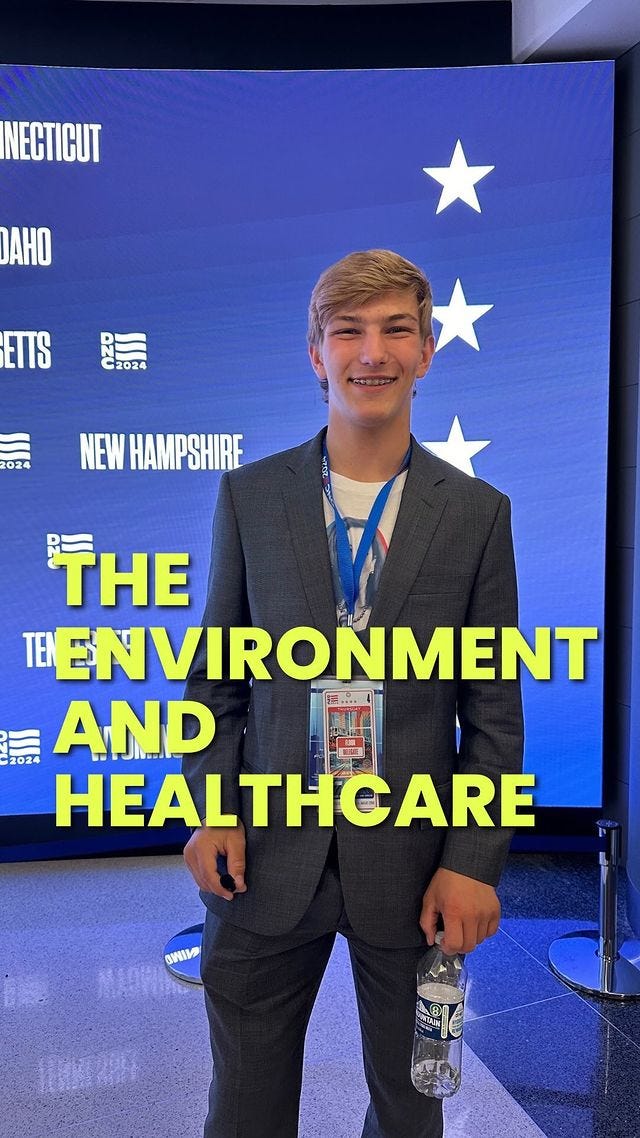A sea change 🌊
Young people have woven themselves into the fabric of the Democratic Party and are being uplifted by institutional leaders. It didn't happen overnight.
Headlines about young voters and content creators coming out of the Democratic National Convention are a true sea change from the 2020 days.
Since 2018, members of Gen Z have woven themselves into the fabric of the Democratic Party and are now uplifted by institutional leaders. But make no mistake about it. The Republican National Convention included creators and had its share of youthful energy around it too. The political power of young people in this election cycle can't be denied and is a major part of the story of 2024 — and that was on display in Chicago this week.
I checked in with Elena Moore, a reporter at NPR covering new voters and youth politics, for her take. As one of the first reporters focused on this beat, she’s traveled the country speaking with young voters in some of the most hard to reach areas.
“I’ve been struck by the sheer number of youth focused events. Both ones run by the DNC and the Harris campaign and from organizers,” Moore told me. “Since Harris took over the ticket, I’ve heard from Democratic leaning young voters and organizers about the real shift in energy they feel. And I think that’s reflected at the DNC too through this programming.”
“I think Democrats know that they have the ability to win over large portions of a growing voting bloc! Voters under 30 overwhelmingly voted for President Biden four years ago. If they can get people that excited again, it could be a winning factor in these seven swing states with razor thin margins,” Moore said.
At a conversation hosted by the Harvard IOP Thursday afternoon (just one example of the many events focused on young people at the convention), Eve Levenson, the national youth engagement director for the Harris campaign, told ABC’s Brittany Shepherd that the youthful energy around the campaign reminds her of the early days of March For Our Lives in 2018 — when after 17 students and staff were killed in the Parkland school shooting, teens turned their anger to action by waking out of school and registering young people to vote in the 2018 midterms.
At the time, March For Our Lives built a chapter-based infrastructure across the country, using social media to deploy digital toolkits and organizing tactics that contributed to their success. The model honed by this digitally savvy generation of pissed off young people during former President Donald Trump’s first term in office became a blueprint for modern youth-led organizing that took on a life of its own amid the pandemic, when almost all 2020 campaign work happened online.
Four years later, these left-leaning young leaders know how to operate. They cut their teeth during Trump-era resistance, and while they turned out for President Joe Biden in 2020, they were largely uninspired by his 2024 campaign.
Many had gotten used to the idea of voting against policies and a candidate rather than for a future-forward vision. But that calculus changed when Harris became the presumptive Democratic nominee, and the genuine organic energy she generates paired with young leaders’ ability to leverage the relationships they’ve built with Democratic Party leaders over the past six-ish years (which meant the DNC had already planned for a slate of youth-focused programming at a Biden convention that was retooled to fit Harris’ next-generation ethos), led us to where we are today.
Here’s a look at some of the other youth events that took place this week:
On Tuesday, the DNC, Voters of Tomorrow, NextGen America, Blue Future and Rise Free hosted a panel and a polling briefing of Voters of Tomorrow’s new poll.
On Wednesday, 300 attendees (150 of which were students) filled the Epiphany Center just a few blocks from the United Center for The UChicago Institute of Politics and Students Learn Students Vote Coalition’s ‘YouthVote Fest,’ the second in a series of two nonpartisan events the groups held this summer (one around the DNC, and one around the RNC in Milwaukee). Speakers included some of those from the main stage of the convention, such as the first member of Gen Z in Congress, Rep. Maxwell Frost, Transportation Secretary Pete Buttigieg, and former Republican Rep. Adam Kinzinger (who endorsed Harris).
“In a democracy, disagreement is good and healthy,” Kinzinger told the crowd at the Epiphany Center, sending a message to the room full of young people that the idea of democracy can transcend party politics.
Also on Wednesday, The Next 50 hosted a ‘Reverse Coattails’ roundtable geared toward creators featuring Michigan state Senate Majority Whip Mallory McMorrow, Wisconsin Assembly Democrats Leader Greta Neubauer, and Georgia House Democrats Whip Sam Park. After their conversation, creators had an opportunity for 1:1 interviews with the young state elected officials.
In an interview with McMorrow, she shared how her own experience facing gun violence helped her better connect with young constituents demanding change on the issue.
The DNC also hosted two ‘youth council’ meetings this week, featuring speakers like Harris’ vice presidential pick Minnesota Governor Tim Walz, Frost, Senator Cory Booker, Rep. Sara Jacobs, who’s the youngest member of Democratic House leadership, and Rep. Ayanna Pressley.
Before Thursday’s event, I spoke with a few of the young attendees in the crowd for the Youth Council meeting, including Evelyn Kemp, 15, and a leader with YMCA Indiana youth & government. While she can’t vote in November (and still has three years before doing so!) she said she’s getting students in her community involved by holding voter registration drives for high school seniors. Noting that Indiana ranks 50th out of the 50 states + Washington, D.C. when it comes to voter turnout, Kemp said she “got really into voter registration and voter outreach.” Though she can’t vote, I asked Kemp what she was hoping to hear from Harris’ speech later that evening. She said: “I really just want to hear about her plans.”
“We’ve heard a lot about what Trump does, and what's wrong with what he's doing and everything. But [I] just want to hear a lot more of plans,” Kemp said.
These events were only the tip of iceberg. There was after hours programming geared toward young people each night like the ‘Hotties for Harris’ party, which was full of IRL memes, Emerge’s ‘After Dark’ party cohosted by Voters of Tomorrow, NextGen America, Alliance for Youth Action (amongst others), and Thursday night, a party hosted by The Bench, a new hub for culture and politics in New York City, at the iconic Manny’s Deli (The Up and Up helped invite attendees to this one).
Beyond these events, the five creators who took the stage and a prime-time speaking slot on the last night of the convention reserved for Frost cemented the fact that the DNC is not only including young people but uplifting their voices and perspectives — and showing the country that they’re proud to do so.
So where will the energy go from here?
As far as Democrats are concerned, Levenson told Shepherd at the Harvard IOP event that the now-Harris campaign was “always prepared to meet this moment.” She said her position leading the campaign’s youth vote work was created earlier (she was hired in January) than the role had been for Biden’s 2020 campaign and Hillary Clinton’s 2016 campaign. The youth groups I spoke to touted their plans for on-the-ground voter engagement, especially on college campuses as students head back to school. But, as Levenson pointed out, the campaign is aware that most young people are not students and their work will extend beyond campuses, too.
If there’s two takeaways I got from the young people in Chicago this week, including the convention’s youngest delegate, Isaac Winkler, who’s 17 and from Minnesota, they’re looking for Harris to focus on her plans for the future and to prioritize the issues that matter to them most.
As I wrote last week, Harris’ proposal on housing and plan to support first-time home buyers by granting $25,000 each to help alleviate the cost is something that is already resonating with this voting bloc. Now it will depend how she leans into other issues that are top of mind, like, as Winkler pointed out: the environment and health care.
Beyond that, patriotism was a focus this week, Thursday night especially. This theme comes up in my conversations with young voters. Often there's a level of skepticism around the idea. But in a pre-DNC listening session, Brandy Star Merriweather, 25 and from Georgia, said Harris' candidacy has changed: "How I see the flag."
Noting a perception that members of Gen Z are shying away from the military opting for tech jobs and careers in business instead, "if she becomes president," Merriweather said: “If there comes a time where I have to register, I will go work out and do whatever I need to do that, but I've never had a candidate that made me feel that way in the time that I voted for president.”
More coverage
The youthful energy at the convention was visible via Era’s Tour style friendship bracelets that were embraced by young and older attendees alike. My latest piece for the New York Times details how the summer-camp staples co-opted by Taylor Swift fans became a way for organizers to build community. Read more here.
I also joined CNN’s Rahel Solomon and NY-1’s Annika Pergament this week to talk about the Harris campaign, young voters, and creators at the convention.
And here’s a great look at how Gen Z could impact the 2024 election in Georgia and beyond for the Atlanta Journal Constitution made by Eli Goodstein and Lindsay Perna.







